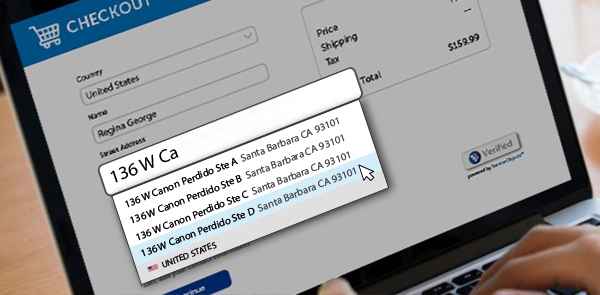Address autocomplete tools have become ubiquitous with ecommerce sites, web forms and business applications. For the customer, they start entering the first few characters of an address, and behind the scenes, an API call is made and returns geo-appropriate address options. The customer selects the appropriate address and the address, city, state and postal code fields are auto-populated on the form.
These tools increase data entry efficiency and reduce conversion friction. Ecommerce sites report a decrease of 30% in shopping cart abandons after adding this feature to their checkout. Although data entry might be faster and checkouts smoother, how accurate and deliverable are the addresses that are suggested?

Are all suggested addresses valid? Can they receive deliveries?
At first glance, all the addresses that are sugggested look to be legitimate, deliverable addresses. However many of the popular services, including Google Places, will programmatically suggest addresses that do not exist or cannot receive deliveries. In short, this happens because the autocomplete tool ‘approximates’ that an address should exist but does not verify that it is a real location that can receive deliveries. One of the simplest examples is when a service extrapolates a range of house numbers beyond what is real. The address below illustrates this, as it looks to be a valid mailing address, given that the street has a range of house numbers:
99 Greenwell Lane
Santa Barbara, CA 93101
In reality, this address does not exist, as the range of house number ends at 47.
How can I verify an autocomplete address?
What most autocomplete tools are missing is address validation. Address validation tools instantly verify, correct, standardize and append an address, ensuring that they are accurate and deliverable, or flagging them when they are not. Most autocomplete tools do not have address validation integrated into them. The good news is it can be easily added to the one you are using or you can replace it with one that has it built-in, like our Global Address Complete.
Address Validation and Google Places
By far, the most popular autosuggest tool is Google Places. In the blog, Global Address Complete vs Google Places Autocomplete, we compared the tools and discuss some of the shortcomings of Google Places, including issues with accuracy, deliverability and its inability to suggest apartment and suite numbers. Global Address Complete was built from the ground to address these shortcomings.
With that said, it might not be feasible to make an immediate switch to a new service. We have worked with a number of our clients to connect address validation services with the auto-suggestor they are using and created a step-by-step video tutorial for integrating Address Validation with Google Places. After integrating validation, you can have confidence that the address selected and entered into your platform is accurate and complete.
Selecting an Address Autocomplete Tool
If you are looking to replace your autocomplete tool or just getting started in evaluating your options, we recommend downloading the whitepaper, Selecting an Address Autocomplete Service, which examines the benefits of adding an address autosuggestion tool to your website, ecommerce and business applications. It also discusses the critical features to consider when choosing an address type-ahead service.
If you have other questions, or would like a demo of our validation or autosuggestor tools, please contact us and we would be happy to help.













